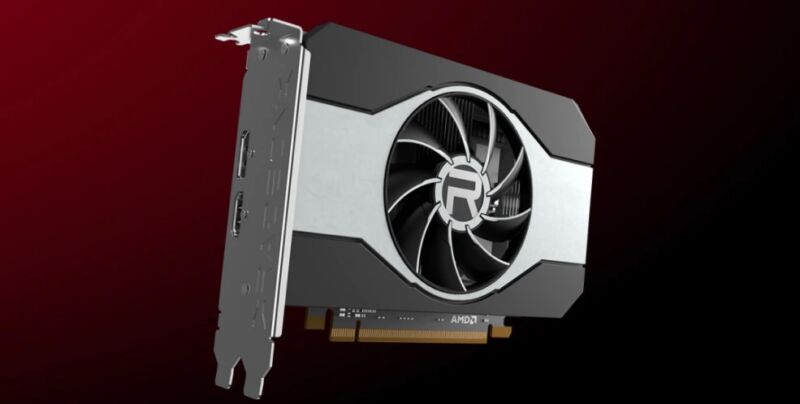
AMD will begin selling its latest budget GPU, the Radeon RX 6500 XT, on January 19th. Its retail price is $199. But the ongoing GPU shortage, caused in part by cryptocurrency miners and scalpers who are snapping up every card they can get, has made it mostly impossible to get any graphics card at its list price over the past year.
Whether the 6500 XT will be any different depends partly on supply, but AMD has also apparently designed the card to make it deliberately less appealing to miners while retaining its usefulness as an entry-level graphics card. Speaking to journalists in a press roundtable earlier this week, AMD Radeon VP Laura Smith talked about how the 6500 XT had been “optimized” for games (a transcript from a now-apparently-deleted PCWorld article is preserved here).
"We have really optimized this one to be gaming-first at that target market," Smith said. "And you can see that with the way that we configured the part. Even with the four gigs of frame buffer. That’s a really nice frame buffer size for the majority of AAA games, but it’s not particularly attractive if you’re doing blockchain-type activities or mining activities.”
Indeed, if you look at the spec sheet of the 6500 XT, you’ll notice a few things that stick out compared to the last-gen RX 5500 XT. For starters, there isn’t an 8GB version of the 6500 XT. The 6500 XT also uses a 64-bit memory interface, which is exceedingly rare in modern GPUs—you’ll sometimes see it in low-end dedicated laptop GPUs like the GeForce MX 450, but discrete GPUs released within the last couple of generations have mostly stuck to 128-bit memory interfaces at a minimum. Both of these decisions make the 6500 XT bad for Ethereum mining in particular, since it needs more than 4GB of video RAM and really likes memory bandwidth.
To make up for the slower memory interface and help the card compete with the RX 570-class cards that AMD wants it to replace, AMD has boosted the clock speed of the RX 6500 XT way up. Its maximum boost frequency is 2815 MHz, up from 1845 MHz in the RX 5500 XT. Even the top-tier 6900 XT only boosts up to 2250 MHz—it just has a lot more GPU hardware and much more memory bandwidth to work with in the first place.
Nvidia has also taken steps to limit its GPUs’ mining capabilities, most notably when it re-issued “LHR” (or Low Hash Rate) versions of the RTX 3000-series cards in mid-2021. But the underlying hardware remains capable of better hash rates, and determined miners have used everything from alternative BIOSes to special software to buggy drivers to restore all or part of those cards’ mining performance. The 6500 XT shouldn’t have those problems—it’s generally not possible to hack more video RAM onto a graphics card. What remains to be seen is whether the design decisions that make the 6500 XT sub-optimal for mining also make it sub-optimal for gaming.
Radeon RX 6500 XT is bad at cryptocurrency mining on purpose, AMD says - Ars Technica
Read More

No comments:
Post a Comment